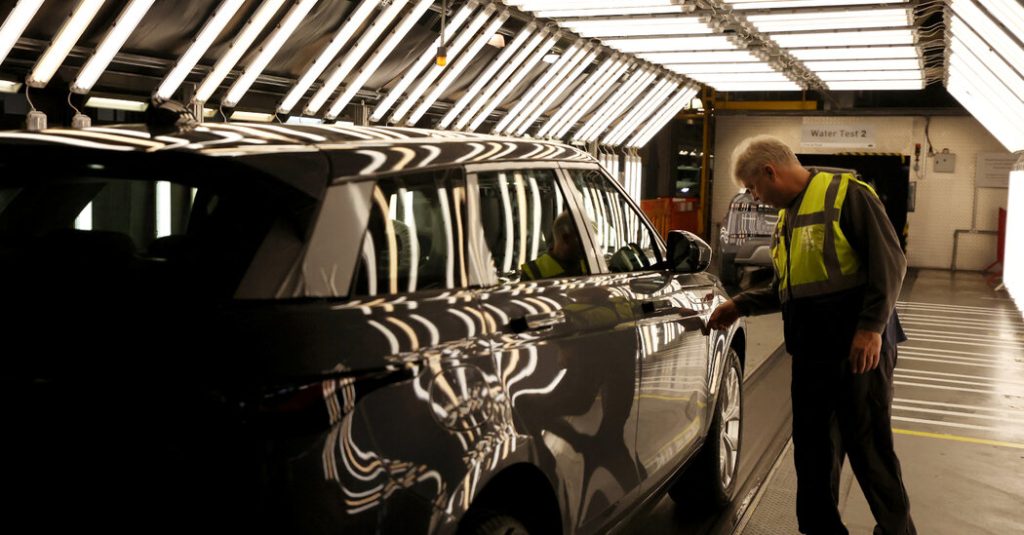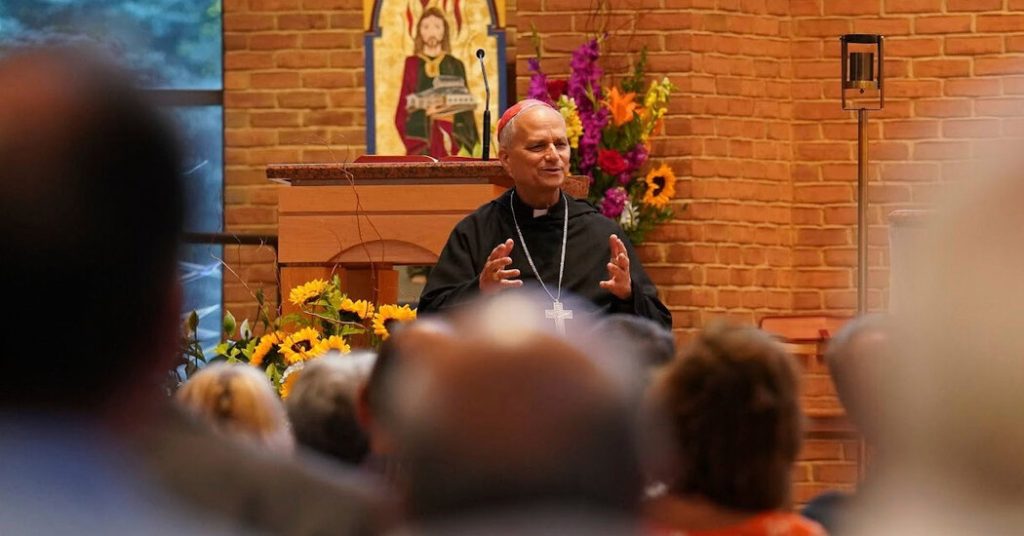SEOUL — RM, the leader of the South Korean pop group BTS, first visited Grand Central Terminal in Manhattan to perform for Jimmy Fallon’s “Tonight Show.” It was early 2020, before the coronavirus lockdown, and in middle of the night, joined by a sizable dance crew, BTS’s seven members put on a raucous display for their single “ON” in the otherwise empty hall.
Late last year, RM returned as a civilian. “It felt really strange to be in Grand Central for the second time with so many people,” he told me one recent afternoon, sitting in the Seoul headquarters of Hybe, the entertainment firm behind the boy band. This time, he said, “I went with my friends, and I’m just a visitor buying tickets.” They jumped aboard a Metro-North train headed to Dia Beacon, the Minimalist art Xanadu in the Hudson Valley. “It’s a utopia,” he said. A room there is devoted to his favorite artist, On Kawara, who spent his career making austere darkly colored paintings that bear the date of their creation in white text.
Dia was the latest stop in a far-ranging art journey that RM, 27, has been on over the past few years as he has been building an art collection and thinking about opening an art space. BTS’s fervent fans (who call themselves Army) have used his social-media posts and press reports to follow after him, boosting attendance at the places that he hits. The veteran dealer Park Kyung-mee credits the singer and rapper with making art more accessible to the general public. “He is throwing away the kind of barrier between the art institutions — galleries and museums — and younger people,” she said in an interview at her gallery, PKM, in Seoul.

A BTS concert at Citi Field, in Queens, New York, in 2018.Credit…Nina Westervelt for The New York Times
RM has also been embracing the role of art supporter, loaning a terra cotta sculpture of a horse by the Korean artist Kwon Jin-kyu to a Seoul Museum of Art retrospective that ran until May, and in 2020 donating 100 million won (about $84,000 at the time) to the National Museum of Modern and Contemporary Art (MMCA) so that it could reissue out-of-print art books and distribute them to libraries. Arts Council Korea, a government-affiliated body, subsequently named him an Art Sponsor of the Year. “We are very happy that RM, who has a high global influence, is an art lover,” the MMCA’s director, Youn Bummo, said in an email.
That global influence has almost unfathomable reach. BTS’s YouTube channel has over 70 million subscribers (another K-pop act, Blackpink, is the only artist with more), and RM’s Instagram alone has 37 million followers. (The MMCA’s has 200,000.) A 35-minute vlog that he recorded about his visit to the Art Basel fair in Switzerland this past summer has racked up almost 6 million views. For the insular, impenetrable world, he may be a dream ambassador.
Which makes it remarkable that his passion for visual art came about through “serendipity, more of an accidental encounter,” said RM, whose given name is Kim Namjun. (He adopted the stage name formally in 2017 to replace the moniker Rap Monster.) He grew up near Seoul, and his parents “did take me to museums, but I don’t think I enjoyed it that much,” he said. Sitting in his hotel room while on tour in 2018, deciding what to do during some downtime, RM opted to venture to the Art Institute of Chicago. Paintings by Seurat and Monet captivated him. “It was almost like Stendhal syndrome,” he said, referring to the condition whereby art induces physical symptoms in a viewer, like lightheadedness or a quickened heart rate. It was a shock to see works that he knew from reproductions in person. “It was like: wow. I was looking at these art pieces, and it was an amazing experience.”
Anytime the subject turned to art, the already energetic musician got especially excited; he was with an interpreter, but he usually switched to English (he is very fluent, and has said that he learned watching “Friends”). “I quit my studying when I was 17 because of this BTS thing, because I was a trainee,” he said, listing off all the practice that involved. “But after 10 years, I met art, and I started to read the books again — seriously.” He is charismatic and a quick study, and you could imagine him being an effective politician or a beloved, slightly eccentric professor.
From an early age, RM was collecting: stamps, coins, Pokémon cards, rare stones (“not expensive ones”) and then toy figures. A large KAWS “Companion” stands in his art-filled recording studio at Hybe, but much of his art is older. A George Nakashima table holds his computer workstation, which has a spare abstract painting by Yun Hyong-keun — just three luminous masses of paint — hovering behind it. A wall is hung with more than 20 works, many by key 20th-century Korean artists like Park Soo Keun, Chang Ucchin and Nam June Paik.
Touring abroad underscored for RM that “my roots are in Korea,” he said, and he has centered his collecting on artists from home, particularly of the generations that lived through the Korean War, military dictatorship and immense economic precarity. These artists remain too-little-known beyond their country. (Other idols have preferred well-recognized blue-chip artists, dealers told me.) “I was able to feel their kind of sweat and blood,” RM said, relating to them as “human beings that were trying to present their artworks in the world.”
The BTS leader comes across as an old soul. Asked to define his taste, he mentioned being drawn to art about “eternity, and that comes because of this fast and hectic aura from this K-pop industry.” His interest is in the past, but he has been trying to learn about newer art. (His solo music, in stark contrast, has a bracingly of-the-moment, even experimental, texture.) He posted from a summer show at the N/A space organized by the emerging gallerist Dooyong Ro, who said that some assumed that the star had bought the work photographed in his post. Not so. Still, RM’s post brought in visitors, even without identifying the location by name, and the ever-assiduous Army found the Instagram of Ro’s own space, Cylinder, he said. “How did they know about this?”
Surrounded by the work of deceased greats, “I feel like they’re watching me.” RM said. “I’m motivated. I want to be a better person, a better adult, because there is this aura that is coming from these artworks on display.” When he is feeling “tired or let down, I sometimes stand there and have a conversation” with them, he said. Standing in front of a spare painting by Yun, he might ask, “Mr. Yun, it’s going to be OK, right?”
RM is mulling his future. Mandatory military service is on the horizon. (The band’s members are spending time on solo projects right now, though their label has been emphatic that BTS is not on hiatus.) A couple months back, RM told Marc Spiegler, the global director of Art Basel, on the fair’s podcast, that he was thinking about opening an art space of some kind. “I want it to be really quiet and calm, but it must still look cool, like Axel,” he told me, name-checking the Belgian designer, antiquarian and gallerist Axel Vervoordt (also a favorite of one of RM’s musical inspirations, Kanye West).
That space is still some ways off, but RM imagines a ground-floor cafe and exhibition areas above showing Korean and international artists in ways that appeal to the young. “I think that there’s something that I can offer as an outsider of the art industry,” he said.
He may be able to claim outsider status only for so long. He recently added one of Roni Horn’s cast-glass cylinders — in a spectral, semi-translucent white — to his collection, and he is becoming recognized as an art expert. Ms. Park, the established Seoul dealer, said that he has found texts about Yun that her gallery did not have in its archives. (She represents the Yun estate, and became Army a few years ago, before she met RM. “I started to study them through YouTube,” she said. “There is so much content. It really requires a long, long time to master.”)
Yun had a harrowing life, as RM recounted to me. Imprisoned four times for political reasons, he narrowly escaped execution on one occasion. In his 40s, he began making meditative paintings by spreading large swaths of diluted, ink-like umber and blue paint across linen or canvas. “It is a complete kind of combination of Western and Eastern, or Asian or Korean styles,” RM said.
Does he have a favorite era of the artist’s work? “I started really liking his works from the ’70s, his paintings, but now I’m so into him, his world, his artwork, that I love everything. I’m not objective anymore,” RM said. “That’s what we call a fan.”






